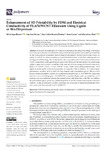Enhancement of 3D Printability by FDM and Electrical Conductivity of PLA/MWCNT Filaments Using Lignin as Bio-Dispersant

Use this link to cite
http://hdl.handle.net/2183/32872
Except where otherwise noted, this item's license is described as Attribution 4.0 International (CC BY 4.0) https://creativecommons.org/licenses/by/4.0/
Collections
- Investigación (EPEF) [590]
Metadata
Show full item recordTitle
Enhancement of 3D Printability by FDM and Electrical Conductivity of PLA/MWCNT Filaments Using Lignin as Bio-DispersantAuthor(s)
Date
2023-02-17Citation
Lage-Rivera, S.; Ares-Pernas, A.; Becerra Permuy, J.C.; Gosset, A.; Abad, M.-J. Enhancement of 3D Printability by FDM and Electrical Conductivity of PLA/MWCNT Filaments Using Lignin as Bio-Dispersant. Polymers 2023, 15, 999. https://doi.org/10.3390/polym15040999
Abstract
[Abstract] To increase the applications of FDM (fusion deposition modeling) 3D printing in electronics, it is necessary to develop new filaments with good electrical properties and suitable processability. In this work, polymer composites filament-shaped with superior electrical performance based on polylactic acid (PLA) carbon nanotubes and lignin blends have been studied by combining solution mixing and melt blending. The results showed that composites achieve electrical percolation from 5 wt.% of nanotubes, with high electrical conductivity. Moreover, the introduction of a plasticizing additive, lignin, improved the printability of the material while increasing its electrical conductivity (from (1.5 ± 0.9)⋅
10−7 S⋅
cm−1 to (1.4 ± 0.9)⋅
10−1 S cm−1 with 5 wt.% carbon nanotubes and 1 wt.% lignin) maintaining the mechanical properties of composite without additive. To validate lignin performance, its effect on PLA/MWCNT was compare with polyethylene glycol. PEG is a well-known commercial additive, and its use as dispersant and plasticizer in PLA/MWCNT composites has been proven in bibliography. PLA/MWCNT composites display easier processability by 3D printing and more adhesion between the printed layers with lignin than with PEG. In addition, the polyethylene glycol produces a plasticizing effect in the PLA matrix reducing the composite stiffness. Finally, an interactive electronic prototype was 3D printed to assess the printability of the new conducting filaments with 5 wt.% of MWCNT.
Keywords
FDM 3D printing
Electrically conductive filaments
PLA/MWCNT
Polymer composite
Lignin
Biopolymers
Bio-dispersants
Electrically conductive filaments
PLA/MWCNT
Polymer composite
Lignin
Biopolymers
Bio-dispersants
Editor version
Rights
Attribution 4.0 International (CC BY 4.0) https://creativecommons.org/licenses/by/4.0/
ISSN
2073-4360






